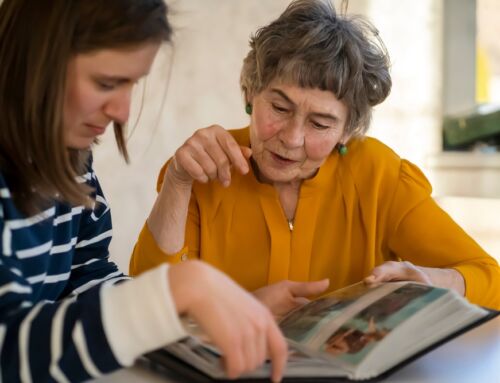We’ve written before about how common loneliness is among seniors in this country. In fact, a 2018 study conducted by AARP Foundation found that 35 percent of Americans over age 45 say they are lonely — more than 1 in 3. That number is even higher among low-income groups (earning less than $25,000 per year) where 1 in 2 are lonely.
There are numerous potential detrimental health effects that loneliness can exacerbate for seniors. Studies have found that loneliness can increase the risk of dementia, depression, and high blood pressure, and is strongly linked to earlier mortality and morbidity. According to 2017 Congressional testimony by Julianne Holt-Lunstad, Ph.D., a psychology professor at Brigham Young University, loneliness can be as bad for your health outlook as smoking, drinking, or cancer.
The AARP study uncovered another eye-opening fact that is worth pondering. One in 3, or 33 percent, of midlife and older people (age 45 and up) who have spoken to their neighbors are lonely. By comparison, 61 percent of people who have never spoken to their neighbors say they are lonely. Put another way, being friendly with ones neighbors cuts loneliness nearly in half.
This statistic is one of the driving forces behind an increasingly popular senior living community model called cohousing.
>> Related: Solving the Baby Boomers’ Loneliness Crisis
Cohousing communities for senior living
Cohousing communities combine private homes with shared indoor and outdoor spaces. They are thoughtfully designed to support an active, independent lifestyle for seniors while also encouraging and facilitating an interdependent community life where neighbors interact with one another frequently.
For example, cohousing residents will have their own house or condominium, but they might have shared patio or green spaces for socializing, as well as a community kitchen with space to cook and enjoy a meal together.
According to SAGE, a senior cohousing advocacy group, cohousing communities are defined by six key principles:
- Participatory process: Future residents take part in the design process to ensure that the community they create meets their needs.
- Neighborhood design: The layout of the homes and shared spaces — clustered in close proximity to one another — is intentional to encourage interaction between neighbors. Walkability is key.
- Common facilities: The shared spaces and facilities are intended for daily use and are a defining element of the community.
- Resident management: Cohousing communities’ residents manage their own community. This includes not only preparation of shared meals but also things like maintenance responsibilities.
- Non-hierarchical structure & decision-making: There is no formal leadership hierarchy in a cohousing community. Decisions are made by meeting and reaching consensus.
- No shared community economy: Community members do not pay each other to perform community-related tasks. Instead, such work is considered a member’s contribution to their shared responsibility to the community.
>> Related: The Senior Loneliness Epidemic & Solutions to “Cure” It
Similarities to other senior living communities
Cohousing shares many similarities to other senior living communities, including continuing care retirement communities (CCRCs, also called life plan communities).
Perhaps most notably, in both a cohousing community and a CCRC, there is an emphasis on socialization and community support as a factor that contributes to improved overall mental and physical wellness. Sharing meals and taking advantage of communal spaces encourages residents of both types of communities to make friends and support one another in good times and bad.
Like a CCRC, the cohousing concept also allows residents to live independently for longer than they might otherwise be able to if they were in a more traditional home and neighborhood. Like a CCRC, cohousing communities are intentionally designed to be “age-friendly” with elements like single-level homes and sidewalks, for example.
>> Related: Making New Friends Should be a Lifelong Endeavor
Cohousing community distinctions
One aspect that separates a cohousing community from a CCRC is the administration or management of the community. Cohousing communities are self-managed by the residents, who also are responsible for their home and community maintenance. Would-be residents of a cohousing community should definitely do their due diligence to be sure they understand exactly what will be expected of them, and what they can (and cannot) expect from their neighbors.
A CCRC, on the other hand, will have a management staff (and often a board of directors) that handles the “business” of running the community. This would include everything from managing staff and maintaining all residences and shared facilities, to organizing activities for residents, creating menus, and more. A resident council may participate in certain decisions that impact the community, but the day-to-day management of the CCRC falls to paid administrators.
There is also a difference in the cost and payment structure between a cohousing community and a CCRC. Cohousing residents typically own their residence. They may pay a homeowner’s association (HOA) fee to cover the cost of things like property taxes and insurance on shared spaces. If agreed to by the residents, they may even opt to share the cost of hiring contractors for certain tasks — perhaps a major repair to a shared facility. Again, potential residents will want to thoroughly understand the HOA terms and conditions.
CCRC residents will have a monthly fee, which covers their rent on their residence, the cost of services like maintenance on their residence and shared spaces, their chosen meal plan, and possibly other services and amenities like housekeeping, garbage removal, and so on. They may also pay an entrance fee when they first move into their CCRC residence, but typically, they do not own the residence.
>> Related: The Key Difference Between Social Isolation & Loneliness
A key difference
Perhaps the most important distinction between a CCRC and a cohousing community, however, is the availability of on-site care services.
A CCRC provides its residents with a full continuum of care on the community’s campus. This includes assisted living-type services, which may be provided within the person’s independent living residence or within the on-site assisted living community, all the way up to full-time skilled nursing care within the on-site healthcare center.
While a cohousing resident could of course hire a provider who offers a spectrum of care services within people’s private homes, the community itself does not provide any such services.
>> Related: What is a “Continuum of Care”?
An innovative concept to confront loneliness
The pandemic has shined a spotlight on the frequency of loneliness as well as some of the negative health impacts it can have. But loneliness was an all-too common issue among seniors in this country even prior to COVID-19.
As more and more people reach retirement age, we as a society must look for ways to confront the “loneliness epidemic.” Innovative housing models, such as cohousing, could be one cost-effective solution that provides the socialization we as human beings need to thrive and also helps seniors remain independent for longer.






